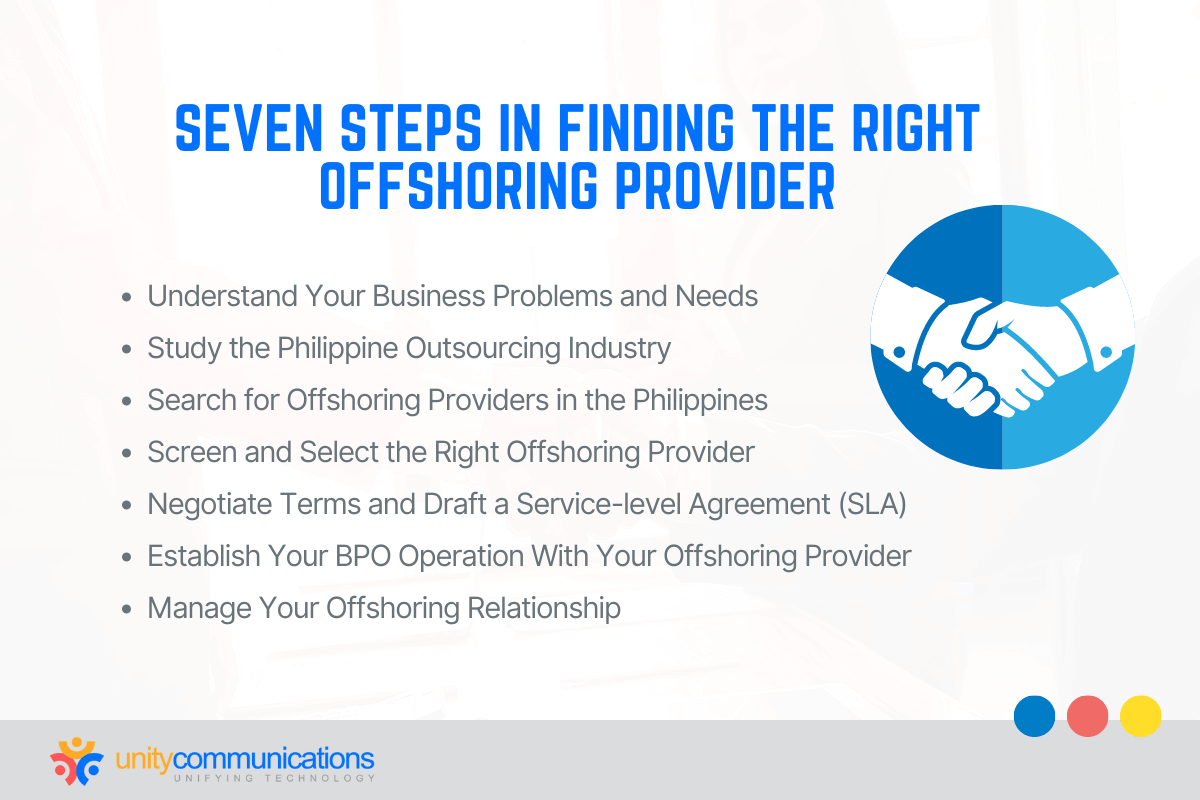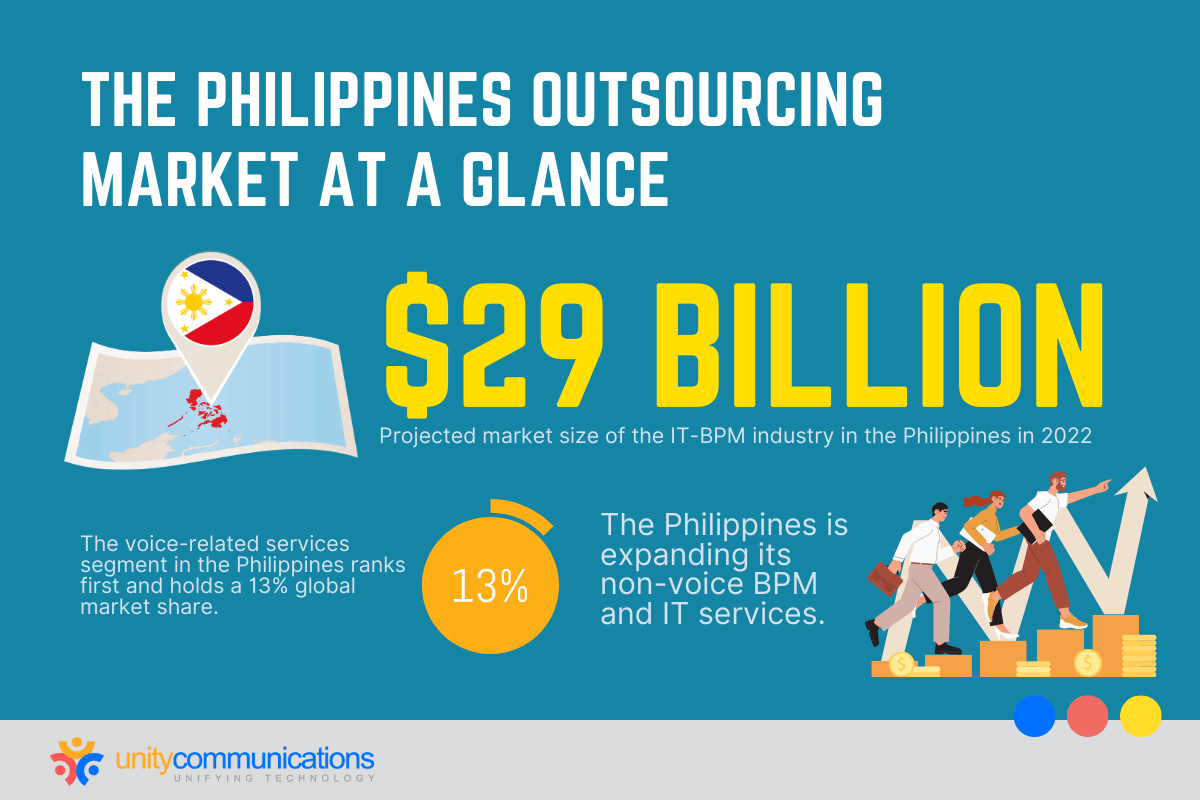Table of Contents
Globalization has transformed the business landscape. Companies nowadays employ offshore outsourcing or the practice of outsourcing to a service provider in a distant country. They outsource business functions to reduce costs and streamline operations.
The Philippines is a popular outsourcing hub known for its competitive labor costs, English-speaking workforce, and robust government support. The country even earned its title as the BPO capital of the world.
How can your business successfully hire an offshoring provider in the Philippines? Find out by reading until the end of this article. It also covers crucial steps in maximizing your outsourcing partnership.
Seven Steps in Finding the Right Offshoring Provider in the Philippines

Business process outsourcing (BPO) involves hiring a third-party service provider to handle specific business functions. You can delegate tasks to an onshore, nearshore, or offshore BPO vendor when outsourcing. Offshore outsourcing, which is also called “offshoring,” is the most viable solution for reducing costs and scaling your operations.
According to Outsource Accelerator, the top outsourcing hubs include the United States, India, Ukraine, Poland, Brazil, South Africa, and Malaysia. The list, however, is not complete without the Philippines.
Working with an offshoring provider in the Philippines offers several potential benefits. The Business Process Association of the Philippines (IBPAP) highlights the following advantages of offshoring to the Philippines:
- Robust and diverse talent
- Cost competitiveness
- Expanding infrastructure
- Strong government, academe, and industry linkages
- Voice and non-voice BPO capabilities
To capitalize on these benefits, your company must take the proper steps to search for, choose, and collaborate with the right offshoring provider. Offshoring makes managing your operations easier, but navigating your outsourcing journey in the right direction requires careful planning.
You can find offshoring success by following the steps below:
1. Understand Your Business Problems and Needs
You are likely considering outsourcing because you have business issues to address and needs to meet. As a general rule, you must first understand these factors before you begin to solve them. Examine your current business operations and take note of the following:
- Business Problems. The first step in your examination should be identifying challenges and issues that hamper your business growth and success. The common problems your business might face include:
- Limited Staffing. Do you need more people to assist your growing customer base?
- Outdated Technology. Do you need the latest technology to improve your service efficiency?
- Delayed Processing. Are you experiencing delays in processing orders and shipping products?
- Unhappy Customers. Are most of your customers unhappy and dissatisfied with your services?
- Low Sales. Do you struggle to boost your monthly sales revenue?
- Business Needs. The next step is determining your company’s needs and how an offshoring provider can help you meet these needs. Below are specific needs your business might have:
- Skilled Workforce. Not only do you require more staff, but you also need professionals and experts for your business.
- Advanced Technology. Your business must leverage the latest technology, such as automation, to improve efficiency.
- Streamlined Processes. You need a third-party service provider to help streamline your processes and scale your business.
- Higher Customer Satisfaction. Access to highly effective BPO agents can help enhance customer experience and improve customer satisfaction.
- Higher Sales Revenue. Hire an offshore provider with a team of telemarketers to help boost your sales.
- Business Functions To Outsource. After identifying your business problems and needs, you can decide which tasks to outsource. You can opt to outsource the following:
- Customer Service. Consider outsourcing to a contact center in the Philippines to improve customer service operations. Providing customers with better support helps you win and keep customers for good.
- Technical Support. Employ technical support outsourcing if your business lacks technical know-how and expertise. Outsourced tech experts and information technology (IT) professionals can provide your end users with technical assistance.
- Sales or Telemarketing. Work with a BPO team of salespeople and telemarketers to better promote your business and sell your products or services.
As you can see, working with an offshoring provider in the Philippines can help your business in more ways than one.
2. Study the Philippine Outsourcing Industry
Research the Philippine outsourcing industry to get a clearer idea of the risks, benefits, and returns involved in partnering with service providers in the country. Here are some essential pieces of information to consider:
- Outsourcing History. The Philippines has a rich outsourcing history that started in the late 1990s. Sykes was the first to establish a multinational company in the country, and eTelecare Global Solutions set up the first call center. But today, the country has over 700 BPO companies, so your options are almost unlimited.
- Current BPO Market. The Philippines has a growing outsourcing market, with its IT-BPM industry projected to reach $29 billion in 2022. The segment ranked first in voice-related services, comprising 13% of the global market share. It is also expanding its non-voice BPM and IT services, so significant improvements are in store for the country’s outsourcing market.
- Laws and Regulations. The Philippine government enacted various laws to govern the outsourcing industry. Some policies, such as the Special Economic Zone Act, promote foreign investments. The Foreign Investments Act and the Omnibus Investments Code are other outsourcing-related regulations you should consider checking.
- Government Programs. The Philippine government implemented various programs to support the outsourcing industry. On top of these programs are the establishment of the Philippine Economic Zone Authority (PEZA) and the IT-BPM Roadmap 2028 initiative.
- Emerging BPO Trends. According to Outsourcing Journal, the latest BPO trends include digital transformation, talent upskilling, process simplifications, and stronger IT-BPM ecosystems. Whether you outsource customer or data entry services, stay on top of these trends to maximize outsourcing and gain a competitive edge.
Studying the outsourcing industry is critical when working with an offshoring provider in the Philippines. This step helps you make informed outsourcing decisions and assess prospective service providers’ capabilities.
3. Search for Offshoring Providers in the Philippines
Now it is time to look for offshoring providers in the Philippines. You can easily find worthy prospects with the following methods:
- Online Search. The internet is an excellent resource for finding BPO companies in the Philippines. You can use search engines, social media platforms, and business directories to look for potential offshore providers. Set specific search criteria based on your business needs using location, industry, services offered, and pricing.
- Industry Referrals. You can get referrals from other professionals and businesses in your industry. This helps you get firsthand recommendations from companies that have worked with BPO service providers in the country. You can also network with other businesses through industry associations, conferences, and online forums.
- Government Recommendations. The Philippine government is an excellent resource for finding BPO firms. Reach out to agencies such as IBPAP, PEZA, the Department of Information and Communications Technology (DICT), and the Department of Trade and Industry (DTI).
- Industry Events. You can attend industry events such as BPO conferences, trade shows, and exhibitions. These events let you network with BPO companies in the country. You can also learn about industry developments and firsthand information from offshore providers.
4. Screen and Select the Right Offshoring Provider
Once you have a list of potential offshore providers, you can screen them. The screening process is the most crucial part of selecting your BPO partner. You want to ensure your hired offshoring provider in the Philippines best fits your business needs and budget.
Consider the following key factors:
- Services. Ensure the service provider offers the services you need, whether customer service, IT support, or data entry. Check their experience and expertise in providing such services. See whether they can offer customized solutions for your business.
- Experience. Look for service providers with a proven track record of BPO success. Check their portfolios, case studies, and client testimonials to gauge their performance. Consider the length of their industry experience and the quality of their services.
- Expertise. Factor in the service provider’s specialization in outsourcing services. You want to work with a BPO company that offers services in your niche. They should have specialized knowledge and skills in your industry.
- Workforce. The contractors are the most valuable assets and integral to business success. As such, assess the service provider’s workforce, including their headcount, skills, and training. Pick a BPO company with a highly skilled workforce, and ensure it invests in employee training and development.
- Technology. The use of technology is now imperative in business. Check the service provider’s technological capabilities, including hardware, software, and security systems. Whether you outsource tech solutions or customer support, choose an offshore provider with the latest technology to increase efficiency and boost security.
- Infrastructure. Apart from technology, consider the service provider’s physical infrastructure. This includes their office facilities, equipment, and connectivity. Opt for a provider with a state-of-the-art facility that can support your business operations.
- Cost. Offshoring is the perfect solution for saving on costs. As such, compare the outsourcing costs of different service providers. Consider their pricing structure, payment terms, and additional charges. The goal is to pick a BPO company to help you save money in the long term.
- Reputation. Reputation is everything in business. Check the service provider’s license, business certifications, and BPO awards. As you partner with another company, you want to work with an offshore provider with a good reputation.
Selecting the right offshoring provider requires a comprehensive evaluation of the factors above. You must prioritize your business needs and preferences. You must choose a BPO partner that provides customized solutions to meet your outsourcing expectations.
5. Negotiate Terms and Draft a Service-level Agreement (SLA)
After selecting an offshoring provider in the Philippines, negotiate the terms and conditions of the business partnership. Both parties should reach an agreement and document the terms in a legally binding contract. This is the SLA, and it should include the following:
- Business Goals. Define your business goals and set expectations for outsourcing. Ensure that your offshoring provider understands them. It should align its services with these objectives to achieve your desired outcomes.
- Key Metrics. Set key performance indicators (KPIs) for your offshoring provider to meet. These metrics measure their performance. Ensure that your offshoring provider agrees to these achievable metrics.
- Work Scope. Clearly define the scope of work, including the tasks, processes, and deliverables expected from your offshoring provider. You should also consider enumerating the BPO agents’ specific duties and responsibilities.
- Policies and Procedures. Discuss with your offshoring provider your business policies. Create standard operating procedures (SOPs) for your outsourced function. Ensure your offshoring provider’s strict compliance with these policies and procedures.
- Contract Breach. Outline the legal and financial consequences of a contract breach. These include fines or penalties, legal action, and even contract termination. Ensure your offshoring provider has clear guidelines to avoid this contract breach.
A well-defined SLA ensures your offshoring partnership’s success.

6. Establish Your BPO Operation With Your Offshoring Provider
Now, you can set up your BPO operation with your offshoring provider in the Philippines. Before starting the operation, follow the steps below.
- Set Up Infrastructure. Examine your offshoring provider’s infrastructure to see whether they can host and run a successful BPO operation. Perform a thorough check on their facilities, office spaces, equipment, and technology.
- Integrate Technology. Your hired BPO vendor usually has the technological resources necessary to run a successful operation. But ensure your tools and technologies are in sync with their systems. For example, integrate your system’s features and data into your provider’s contact center as a service (CCaaS) software for customer service.
- Hire and Train Talent. Work with your offshoring provider to hire and train candidates required for your BPO operation. Establish clear guidelines for recruitment and training to ensure contractors fit the roles.
- Build Workforce and Management. Establish the organizational structure for your BPO operation. Clearly define the roles and responsibilities of the management team and their rank-and-file workers.
- Set SOPs. SOPs are critical to each business function and process. Draft step-by-step instructions and guidelines for quality control.
- Test the BPO Operation. Conduct thorough testing of your BPO processes before the actual operation. You can perform a pilot run with a small team to identify and resolve any issues.
- Kick-start the Outsourcing Operation. Once the testing is complete, it is time to launch your outsourcing operation in the Philippines!
7. Manage Your Offshoring Relationship
Your outsourcing operation has finally kicked off. But that does not mean you can entrust everything to your offshoring provider in the Philippines. Remember that outsourcing involves business partnerships. Managing your relationship with the offshore provider is critical to your success.
Whether you’re employing front- or back-office outsourcing, here are a few management tips for you:
- Open Lines of Communication. Communicate with your offshoring provider regularly to facilitate collaboration, share feedback, and resolve issues. Schedule regular check-ins, establish reporting protocols, and set feedback mechanisms.
- Ensure Constant Collaboration. Regularly coordinate with your offshore provider to ensure it meets your business needs and goals. Conduct regular performance reviews, provide progress updates, and share best practices.
- Track BPO Performance. Monitor your BPO operation’s performance to ensure your offshore team meets your goals and expectations. Track key metrics such as service efficiency, quality control and compliance, and customer satisfaction.
- Make Adjustments. If your BPO team’s performance declines, make necessary changes to the operation. Optimize your operation by upskilling your offshore team and leveraging new technologies.
- Implement Best Practices. Share best practices and lessons learned with your offshoring provider. The goal is to improve your business performance, drive innovation, and achieve success.
- Celebrate BPO Success. Acknowledge the offshore team’s efforts and celebrate BPO success to boost your morale and motivation. Recognize team members’ achievements, celebrate milestones, and offer incentives for excellent performance.
The Bottom Line
Working with an offshoring provider in the Philippines can be highly beneficial and cost-effective for optimizing your business operations. Have the right mindset and implement the best strategies to ensure a successful partnership.
The Philippines offers much, from cost-effective labor and skilled talent to solid government support and a favorable business environment. Follow the crucial steps outlined here to find, hire, and work with a reputable BPO company. These steps also help you set up a successful outsourcing operation.
So grab this outsourcing opportunity and maximize your partnership with a Philippine service provider.




